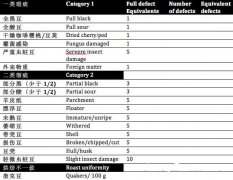Quality Coffee Encyclopedia Coffee Coffee commonly used in English

Whether you are a barista or an enthusiast, when you start to like coffee, you are destined to deal with a lot of technical terms, and the following common words will be the golden key to unlock your coffee password.
[Barista] the English name of a barista is everyone who stands in front of the coffee machine and is familiar with every method of making coffee drinks and who can make "exclusive" coffee for you. Similar to the bartender "Bartender".
[shot] A 1-ounce espresso (about 30ml) is a common term for Bairsta. If you want to make the coffee more flavorful, you can tell the waiter to add one or two more shot espresso for me.
[espresso] espresso, roasted at a depth of 7 grams, is ground into a very fine coffee powder. After 9 atmospheric pressure and 90 degrees Celsius steam, 30 milliliters of strong coffee liquid is rapidly extracted in a short time of 20 seconds called "Espresso".
[Single] refers to a cup of 30ml Espresso made from a single serving of coffee beans (about 7g-9g).
[Double] refers to the Espresso that boils 60ml from coffee beans of double portions (about 14g-18g).
[Triple] means to brew a cup of 90ml Espresso out of three portions of coffee beans (about 21g-27g).
If you want to make the coffee more full-bodied, you can tell the waiter to add more for me.
[cream] specifically refers to a layer of golden oil floating on Espresso. In general, the fresh coffee beans are more rich in oil, showing tiger skin patterns. A perfect Espresso can hold its Cream for about 2 minutes.
[small/medium/large] these three words are small cup (about 240ml), medium cup (about 360ml) and large cup (about 480ml). In Starbucks, it is also represented by short, tall and Grande. And medium coffee tends to have the highest order rate.
[milk foam] it is called milk foam or milk foam in Chinese, which is the delicate foam formed by the fat in milk under the action of steam. If you don't like foam, you can say no foam to the waiter.
Important Notice :
前街咖啡 FrontStreet Coffee has moved to new addredd:
FrontStreet Coffee Address: 315,Donghua East Road,GuangZhou
Tel:020 38364473
- Prev

Introduction to the varieties of defective coffee beans
Coffee beans have many flaws, and there are a variety of flaws. There are many reasons for defects. Defects may affect our taste experience of coffee at different levels, and may also affect our health. However, many defects that can be clearly seen in raw beans can be quickly invisible once baked. Therefore, most of the coffee cooked beans we usually see are uniform in appearance and consistent in appearance.
- Next

Ethiopian native species of fine coffee varieties
Honey kiss NekisseN2 [origin]: 90 + Ethiopian Wellega (Woliga) and Sidama (Hidamo) producing areas [season]: 2013-2014 [variety]: Ethiopian native species [Level]: 12 [altitude]: 17502000m [treatment]: sun [flavor]: taste clean, multi-layered. Peaches, berries, passion fruit and cream, milk skillful
Related
- Beginners will see the "Coffee pull flower" guide!
- What is the difference between ice blog purified milk and ordinary milk coffee?
- Why is the Philippines the largest producer of crops in Liberia?
- For coffee extraction, should the fine powder be retained?
- How does extracted espresso fill pressed powder? How much strength does it take to press the powder?
- How to make jasmine cold extract coffee? Is the jasmine + latte good?
- Will this little toy really make the coffee taste better? How does Lily Drip affect coffee extraction?
- Will the action of slapping the filter cup also affect coffee extraction?
- What's the difference between powder-to-water ratio and powder-to-liquid ratio?
- What is the Ethiopian local species? What does it have to do with Heirloom native species?

